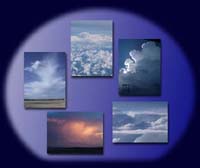Precipitation |
|
| Objects in Clouds | |
| Falling Rain Droplet | |
| Virga and Praecipitatio | |
| Microburst | |
| Rainshaft | |
| Falling Cloud | |
| Tropical Rain | |
| Tropical Rainforest | |
| Flood | |
| Diamond Dust | |
| Overview | |
Diamond Dust
|
During arctic winter the phenomenon of "Diamond Dust"
often occurs. This is a snow-like precipitation from blue, totally
cloudless sky. Sky.jpg shows the blue sky during the precipitation
event that took place for several hours. Very fine, sinking ice-crystals
can be noticed on the other images. These are no snow flakes, i.e.
agglomerates from needle-like ice-crystals, but single crystals.
The precipitation is so fine that one barely can recognize it -
except in the back light. Dust2.jpg and Dust5.jpg were not taken
with the back light of the sun and therefore only few ice-crystals
can be noticed. The hexagonal plate structure of the ice-crystals
becomes clear because of the light reflection on some of the images.
|
The pictures suggest a dense, intensive precipitation, which - in reality - is so not noticeable and does not look that way. Dust2.jpg shows more realistic what an observer might see. Because it was almost totally calm during the precipitation event
it can be ruled out that these were ice-crystals which have been
suspended from the ground. This precipitation comes "out of
the blue" under conditions of extreme dryness of the air and
moderately low temperatures (here around -15 deg C). (There was
an inversion in a height of 100 m above the observer which was noticeable
by a power plant plume. |
Under these conditions water vapour deposits onto slowly depositing aerosol particles by diffusion. Within several hours those precipitation particles are generated by very slow "deposition - diffusion growth". They reached the ground with a velocity of around 1.8 m/s, i.e. they passed the observer in 1 second. This results in a particle diameter of around 2 mm.
|
![]()






